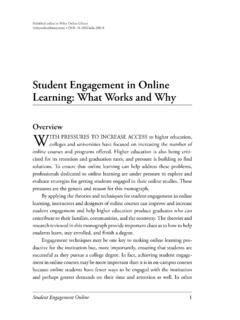Transcription of 21st Century Learning Environment - ed
1 1 21st Century Learning Environment Models 21st Century Learning Environment Classrooms with 21st Century Learning environments are well equipped with computer hardware, software, electronic whiteboards and rich digital and online curricular resources. When you enter a 21st Century Learning Environment , you quickly see that interactive Learning , higher level thinking skills, and student engagement are pervasive, whether students are Learning math, science, reading, or history. 21st Century Learning environments provide opportunities for collaboration and access to relevant content that would not usually be available to the highest need students being served by these programs.
2 Collaborative planning, investment in core components for technology, intensive professional development training teachers not only how to use technology but also how to integrate technology into the curriculum, rich digital content and IT support are some of the key elements necessary to transform schools. Core Components Teacher Laptop & Productivity Tools Presentation Device Collaborative Learning System (Interactive Whiteboard), LCD or Plasma TV Projector (if needed for the presentation device or collaborative Learning system) Learner Response Devices for Formative Assessment & Individualized Instruction Document Camera Digital Camera Video Camera Robust Software & Digital Content Printer Company Lead Training (PD)
3 On Technology Functionality Additional Elements to Consider Based Upon Location and Curricular Goals Mobile Learning Lab or Centralized Computing Stations Webcam for Teacher Computer Flashdrives for each Student Audio System Courseware and Content Aligned to Standards and Curricular goals Safe and Secure Communication & Community Building Tools with Web Functionality for Teacher and Administrator Cadres as well as Home/School Connections Formative Assessment for Individualization of Learning Student, Classroom & School Data Collection, Management & Reporting Learning Management Systems Learning management systems combine online course management, communication and collaboration tools.
4 Online tools may include a discussion forum, file exchange, email, online journal/blog, real time chat, interactive whiteboard, bookmarks, calendar, search tool, group work, electronic portfolio, registration integration, hosted services, quizzes/surveys, marking tools/gradebook, student tracking, content sharing, and an object repository, amongst other tool offerings. Comprehensive Professional Development Integration The 21st Century Classroom not only has modern tools, equipment and content but it includes a teacher trained to use the tools effectively with innovative teaching approaches that integrates the interactivity and engaging content technology brings to curriculum.
5 Teachers engage in on going and job embedded professional development through access to on line courses, professional Learning communities, education portals with resources and lesson plans, and others. 2 21st Century Learning Environment Models Technology Coaches/Integration Specialists Experimental studies have proven that mentoring and coaching relationships benefit from the use of technology in many ways. In a professional development context, coaches and mentors provide teachers with leadership for lesson planning and implementation, honing specific teaching strategies, developing and identifying instructional materials and resources, and modeling professional discussions about student Learning .
6 As a result of delivering these services using technology, the coaching and mentoring process is compressed through near real time service. This is particularly critical in rural and inner city areas where these opportunities are often limited. Instructional technology coaches or mentors in schools provide opportunities for collaboration in planning and co teaching to help teachers utilize new practices and resources. Online Courseware Online courseware provides teachers access to online courses. Teachers may have access to several clusters of courses. For example, in one cluster, teachers learn what types of curricula and Learning principles will ensure students success in the 21st Century workplace and post secondary education.
7 In another cluster, teachers receive the skills and knowledge necessary to implement technology in the classroom through Web enhanced lessons, project based Learning , and virtual field trips. Professional Learning Communities Online Learning communities provide teachers across schools, school districts and states the opportunity to share resources, highlight strengths and gain support in weaker areas. The purpose of online Learning communities is the opportunity for collaboration in a non threatening Environment and for teachers to learn and share without time or travel constraints. Education Portals Education Portals offer a one stop set of resources for educators, parents, and students to support teaching, Learning , and leading.
8 Portals provide access to shared resources and create an entry point to other information or services. This onestop shopping enhances professional development experiences by administrators, teachers and coaches with the online support anytime and anywhere. Portals often include: subscriptions, data systems, content standards, lesson plans, courses of study, research based training resources, model classroom examples, engaging interactive media, Web resources, listservs, online portfolios, and other educational resources. A portal allows educators to quickly search for lesson plans or other resources by content standard, grade level, specific student and classroom needs, and/or topic.
9 Statewide Longitudinal Data Systems Statewide longitudinal data systems are crucial for accountability and to provide comparative data across district and state lines to ensure all students are receiving relevant instruction aligned to baseline academic standards. States can expand their current state data systems by integrating test scores with key demographic and achievement information from students. States can help schools and districts address how relevant formative assessment and demographic data can flow up to the state to inform systemic changes in policies regarding school improvement and reform.
10 Formative Assessments Through the use of technology, classroom teachers can conduct innovative micro assessments of all students for the purpose of improving instruction. This provides exciting new opportunities for the remediation or enrichment of each and every student helping all students reach their highest potential. This won t happen without adequate teacher training, IT support to ensure the reports delivered to teachers are relevant and user friendly, and strong leadership about the importance of data analysis to drive classroom instruction at the school, district, and state levels of the educational system.














